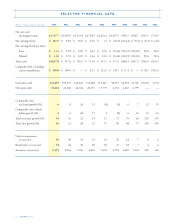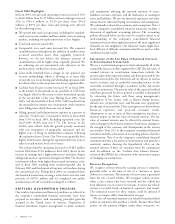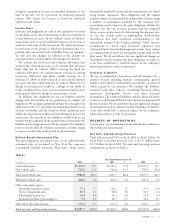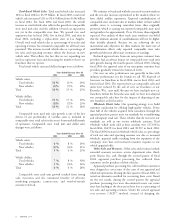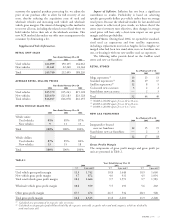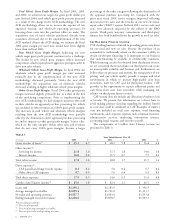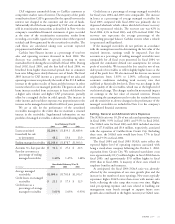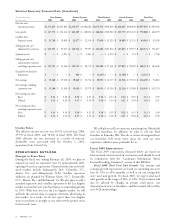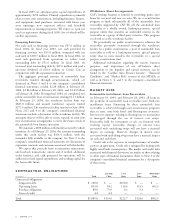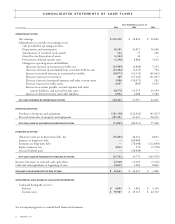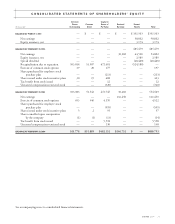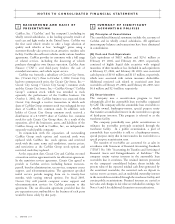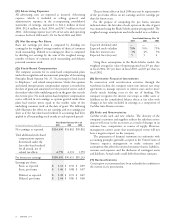CarMax 2004 Annual Report Download - page 28
Download and view the complete annual report
Please find page 28 of the 2004 CarMax annual report below. You can navigate through the pages in the report by either clicking on the pages listed below, or by using the keyword search tool below to find specific information within the annual report.
In fiscal 2005, we anticipate gross capital expenditures of
approximately $250 million. Planned expenditures primarily
relate to new store construction, including furniture, fixtures,
and equipment; land purchases associated with future year
store openings; new corporate offices; and leasehold
improvements to existing properties. We expect to open ten
used car superstores during fiscal 2005, five of which will be
satellite superstores.
Financing Activities
Net cash used in financing activities was $47.6 million in
fiscal 2004. In fiscal year 2003, net cash provided by
financing activities was $39.8 million, compared with net
cash used of $105.7 million in fiscal 2002. In fiscal 2004, we
used cash generated from operations to reduce total
outstanding debt by $51.6 million. In fiscal 2003, we
increased total outstanding debt by $67.6 million and paid a
one-time dividend of $28.4 million to Circuit City in
conjunction with the separation transaction.
The aggregate principal amount of automobile loan
receivables funded through securitizations, which are
discussed in Notes 3 and 4 to the company’s consolidated
financial statements, totaled $2.20 billion at February 29,
2004, $1.86 billion at February 28, 2003, and $1.49 billion
at February 28, 2002. During fiscal 2004, we completed two
public automobile loan securitizations totaling $1.11 billion.
At February 29, 2004, the warehouse facility limit was
$825.0 million and unused warehouse capacity totaled
$272.5 million. The warehouse facility matures in June 2004.
Notes 2(C) and 4 to the company’s consolidated financial
statements include a discussion of the warehouse facility. We
anticipate that we will be able to renew, expand, or enter into
new securitization arrangements to meet the future needs of
the automobile loan finance operation.
We maintain a $300 million credit facility secured by vehicle
inventory. As of February 29, 2004, the amount outstanding
under this credit facility was $104.4 million, with the
remainder fully available to the company. See Note 9 to the
company’s consolidated financial statements for discussion of
expiration, renewals, and covenants associated with this facility.
We expect that proceeds from securitization transactions;
sale-leaseback transactions; current and, if needed, additional
credit facilities; and cash generated by operations will be
sufficient to fund capital expenditures and working capital for
the foreseeable future.
Off-Balance Sheet Arrangements
CAF’s lending business is limited to providing prime auto
loans for our used and new car sales. We use a securitization
program to fund substantially all of the automobile loan
receivables originated by CAF. We sell the automobile loan
receivables to a wholly owned, bankruptcy-remote, special
purpose entity that transfers an undivided interest in the
receivables to a group of third-party investors. This program
is referred to as the warehouse facility.
We periodically use public securitizations to refinance the
receivables previously securitized through the warehouse
facility. In a public securitization, a pool of automobile loan
receivables is sold to a bankruptcy-remote, special purpose
entity that in turn transfers the receivables to a special
purpose securitization trust.
Additional information regarding the nature, business
purposes, and importance of our off-balance sheet
arrangement to our liquidity and capital resources can be
found in the “CarMax Auto Finance Income,” “Financial
Condition,” and “Market Risk” sections of this MD&A, as
well as in Notes 3, 4, and 5 to the company’s consolidated
financial statements.
MARKET RISK
Automobile Installment Loan Receivables
At February 29, 2004, and February 28, 2003, all loans in
the portfolio of automobile loan receivables were fixed-rate
installment loans. Financing for these automobile loan
receivables is achieved through asset securitization programs
that, in turn, issue both fixed- and floating-rate securities.
Interest rate exposure relating to floating-rate securitizations
is managed through the use of interest rate swaps.
Receivables held for investment or sale are financed with
working capital. Generally, changes in interest rates
associated with underlying swaps will not have a material
impact on earnings. However, changes in interest rates
associated with underlying swaps may have a material impact
on cash and cash flows.
Credit risk is the exposure to nonperformance of another
party to an agreement. Credit risk is mitigated by dealing with
highly rated bank counterparties. The market and credit risks
associated with financial derivatives are similar to those relating
to other types of financial instruments. Refer to Note 5 to the
company’s consolidated financial statements for a description
of these items.
26
CARMAX
2004
CONTRACTUAL OBLIGATIONS
Less than 1 to 3 3 to 5 More than 5
(In millions)
Total 1 Year Years Years Years
Contractual obligations:
Long-term debt $ 100.0 $ — $100.0 $ — $ —
Operating leases 893.0 58.2 116.4 115.5 602.9
Purchase obligations 88.4 73.0 6.3 9.1 —
Lines of credit 4.4 4.4 — — —
Total $1,085.8 $135.6 $222.7 $124.6 $602.9


